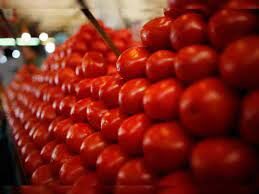Table of Contents
Restaurants in Ahmedabad are currently grappling with the added costs brought about by soaring tomato prices, which range from Rs 150-160 per kilo. The fondness for tomato-based dishes among Gujaratis unites cuisines like Indian curries, Italian pizza, Mexican salsas, and traditional Gujarati sev tamatar.

Consequently, methods to diminish reliance on this tangy ingredient are actively being sought by restaurants. Restaurant owners were spoken to ascertain if the increased tomato prices have affected the availability of tomato-based dishes on their menus or if they are considering substituting or reducing the use of tomatoes in any of their dishes due to the price surge.
Ensuring no tomatoes are wasted in the restaurant kitchens is a must.
Different Methods of Coping
The menu cannot be changed, and the tomato-based dishes have not been discontinued, but the price rise is affecting the food cost. Fresh salsas are made, and tomatoes are generously used in several dishes. The loyal clientele is aware of the signature taste in restaurants, so the menu cannot be modified or considered substitutes. Tomato is an essential ingredient in Indian and Mexican cuisine, which is specialized in, so substitutes cannot be used, and the extra cost is being borne.
Additionally, the prices of the dishes cannot be adjusted due to the incurred additional costs of printing new menus. However, the quantity of tomatoes has not been reduced; instead, they are being used optimally. The kitchen staff has been instructed to monitor tomato usage, control the amount used, and maintain a balanced proportion. Ensuring no tomatoes are wasted in the kitchen is a priority.
There are readymade tomato gravies available in the market, but the fresh taste is preferred. Currently, the increase in tomato prices is roughly 30%, which is still manageable. However, if the prices continue to escalate, consideration will be given to suppliers who provide ready-made gravies and sauces since their rates remain consistent. For example, if the cost of readymade tomato gravy is around Rs180/kg, and fresh tomatoes cost, let’s say, Rs200/kg, then purchasing more readymade gravies will be explored.
If the prices keep escalating like this in the future, a shift might occur towards using more in-house tomato purees for preparing tomato-based dishes. Currently, since people are cutting down on tomatoes at home, they desire more tomato soups at the unlimited buffets.
Logistics in Restaurants
While curating the menu, the average prices of fruits and vegetables around the year are considered, and preparation for a rainy day is necessary. Currently facing losses, tomatoes are still being used because the taste and quality of the food are not to be compromised. In pizzas and sandwiches, good tomato puree can still be used. Some chefs also opt for a 50:50 mix (tomato and tomato puree), while the other alternative is to use readymade gravies, which can be stored around the year. For readymade gravies too, some chefs prefer a 50:50 or 80:20 mix.
The price of tomatoes goes up every year during monsoons, hence alternatives must be prepared. The use of amchur powder and lemons instead of tomatoes ensures a similar tangy taste. Tomato puree is avoided due to long-term health concerns.
Inflation in India is impacting vegetable prices, leading to significant increases in the cost of essential produce. Rising transportation and production costs, coupled with supply chain disruptions, have contributed to the surge in vegetable prices, posing challenges for households and affecting overall food affordability and accessibility in the country













